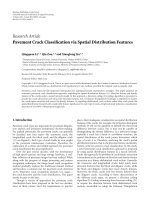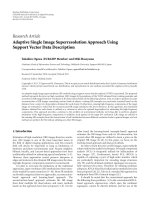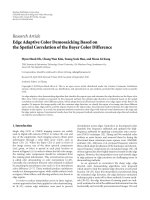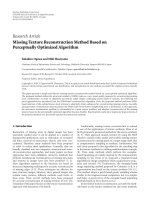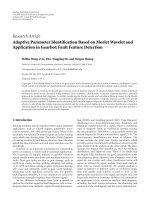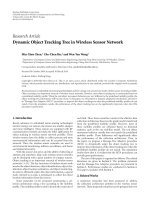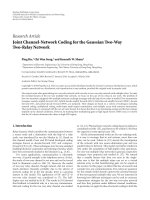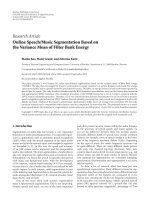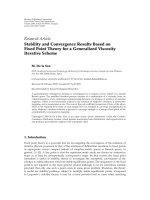Báo cáo hóa học: " Research Article Scalable Multiple-Description Image Coding Based on Embedded Quantization" ppt
Bạn đang xem bản rút gọn của tài liệu. Xem và tải ngay bản đầy đủ của tài liệu tại đây (756.69 KB, 11 trang )
Hindawi Publishing Corporation
EURASIP Journal on Image and Video Processing
Volume 2007, Article ID 81813, 11 pages
doi:10.1155/2007/81813
Research Article
Scalable Multiple-Description Image Coding Based on
Embedded Quantization
Augustin I. Gavrilescu,
1
Fabio Verdicchio,
1
Adrian Munteanu,
1
Ingrid Moerman,
2
Jan Cornelis,
1
and Peter Schelkens
1
1
Department of Electronics and Informatics (ETRO), Vrije Universiteit Brussel (VUB) and Interdisciplinary Institute for
Broadband Technology (IBBT), Pleinlaan 2, 1050 Brussels, Belgium
2
Department of Information Technology (INTEC), Universiteit Gent (UGent) and Interdisciplinary Institute for
Broadband Technology (IBBT), St Pietersnieuwstraat 41, 9000 Ghent, Belgium
Received 14 August 2006; Revised 14 December 2006; Accepted 5 January 2007
Recommended by B
´
eatrice Pesquet-Popescu
Scalable multiple-description (MD) coding allows for fine-grain rate adaptation as well as robust coding of the input source.
In this paper, we present a new approach for scalable MD coding of images, which couples the multiresolution nature of the
wavelet transform with the robustness and scalability features provided by embedded multiple-description scalar quantization
(EMDSQ). Two coding systems are proposed that rely on quadtree coding to compress the side descriptions produced by EMDSQ.
The proposed systems are capable of dynamically adapting the bitrate to the available bandwidth while providing robustness to
data losses. Experiments performed under different simulated network conditions demonstrate the effectiveness of the proposed
scalable MD approach for image streaming over error-prone channels.
Copyright © 2007 Augustin I. Gavrilescu et al. This is an open access article distributed under the Creative Commons Attribution
License, which permits unrestricted use, distribution, and reproduction in any medium, provided the original work is properly
cited.
1. INTRODUCTION
Performing compression is of paramount importance in
modern multimedia systems in order to improve the band-
width usage and to reduce the costs associated with the signal
transport. Sending image and video data in an efficient way
over an ideal (error-free) channel basically consists in remov-
ing the redundancy from the input signal. Additionally, in the
context of browsing through large data sets and fast access to
large images transmitted over low-bandwidth channels, em-
ploying a compression scheme with progressive transmission
capabilities is of critical importance. Scalable image coding
technologies [1] enable the media providers to generate, in a
single compression step, a unique bitstream from which ap-
propriate subsets, producing different visual qualities, frame
rates, and resolutions can be extracted to meet the prefer-
ences and the bitrate requirements of a broad range of clients.
Moreover, at the decoder side it is possible to refine the image
quality as more data is received.
On the other hand, in data communications over un-
reliable channels (e.g., mobile wireless or best-effort net-
works), achieving overall performance optimization is not
always similar to minimizing the redundancy within the in-
put stream. Hence, streaming data over networks involves
much more than taking the output of a standard coder and
writing it to the socket, justifying entirely the need for a new
paradigm called robust source coding. In this context, sev-
eral multiple-description (MD) coding techniques (e.g., [2–
6]) have been introduced to efficiently overcome the chan-
nel impairments over diversity-based systems, allowing the
decoders to extract meaningful infor mation from a subset of
the transmitted data. MD coding systems are able to generate
more than one description of the source, such that ( i) each
description independently describes the source with cer t ain
fidelity, and (ii) when more than one description is available
at the decoder, these descriptions can be combined to en-
hance the quality of the decoded signal.
In light of the above, we may conclude that on one hand,
modern image compression systems have to provide scala-
bility in order to meet the heterogeneous nature of networks
and clients in nowadays communication systems, and on the
other hand, efficient robust coding needs to be provided as
well, in order to cope with the challenges posed by multi-
media communication over error-prone channels. The paper
2 EURASIP Journal on Image and Video Processing
addresses this combined problem, and proposes a class of
scalable MD image coding systems as a solution to this prob-
lem. The key component in these systems is given by em-
bedded multiple-description scalar quantization (EMDSQ)
[7–11]. EMDSQ belongs to the broad family of multiple-
description coding approaches based on scalar quantization.
The basic principle of MD based on scalar quantization
(MDSQ) was firstly proposed by Vaishampayan in [3], while
the optimal design of central and side quantizers has been
extensively studied for the fixed-rate case in [12, 13]. The
classical MDSQs are fixed-rate quantizers. This will lead to
the impossibility to design embedded coding schemes having
the ability to refine the image quality at the decoder side as
more information is received. This problem has b een solved
in [14], where multiple-description uniform scalar quantiz-
ers (MDUSQ) have been proposed, simultaneously enabling
multiple-description coding and a scalable encoding of the
input source.
More recently, we proposed generic EMDSQ [7–11]pro-
ducing double-deadzone central quantizers, known to be op-
timal and very nearly optimal at high and low rates, re-
spectively, [1]. This will allow the coding systems employ-
ing EMDSQ to provide state-of-the-art coding results in data
communications under realistic network conditions, and due
to the embedded nature of EMDSQ, also to support progres-
sive transmission and fine-grain rate adaptation of the out-
put stream.
In contra st to MDUSQ, the design of EMDSQ treats the
generic case of a n arbitrary number of descriptions. Another
important feature of EMDSQ consists in their unique abil-
ity to control not only the overall redundancy but also the
redundancy, at each distinct quantization level between the
descriptions.
In this paper, we propose a new scalable MD coding ap-
proach for images that couple EMDSQ and a customized ver-
sion of our wavelet-based quadtree (QT) coding algorithm,
originally proposed in [15, 16].Thesystemwillbereferred
to as MD-QT.
In the proposed MD-QT approach, EMDSQ is used in
order to produce a scalable MD representation of the wavelet
coefficients, while QT coding is employed in order to en-
code for each description the localization information, in-
dicating the positions of the coefficients that are found to
be significant at each quantization level. However, simply
coupling EMDSQ with QT coding only provides a multiple-
description representations of the quantization indices. A
critical design aspec t is to extend the MD paradigm and to
produce multiple representations of the localization infor-
mation as well. This idea is followed in our design of an
enhanced MD-QT image coding system. The experimental
results show that in the context of transmission over error-
prone packet networks, the enhanced MD-QT system pro-
vides a substantial per formance increase in comparison to a
simple MD-QT approach.
The rest of the paper is structured as follows. Section 2
presents the EMDSQ focusing on two main issues:
Section 2.1 describes the way EMDSQs are constructed by
recursive splitting of an index assignment (IA) matrix, while
Section 2.2 describes the mechanism that allows for a flexible
redundancy allocation for each distinct quantization level.
The proposed MD-QT algorithm is detailed in Section 3.1.It
is followed with Section 3.2 where an enhanced version of the
algorithm extending the MD coding paradigm to all types of
encoded information is presented. The experimental results
are presented in Section 4, illustrating the rate-distortion
performances of the proposed still-image codecs in data
transmission over error-prone networks. Finally, Section 5
summarizes the conclusions of our work.
2. EMBEDDED MULTIPLE-DESCRIPTION
SCALAR QUANTIZATION
2.1. Embedded index assignment
An EMDSQ is an embedded scalar quantizer designed to
work in a diversity-based communication system. We can de-
fine EMDSQ as a set of embedded side quantizers generating
two descriptions denoted by Q
0
m
, Q
1
m
, , Q
P
m
,wherem rep-
resents the description index (m
= 1, 2) and p represents the
quantization level (0
≤ p ≤ P). The corresponding set of
embedded central quantizers is denoted by Q
0
, Q
1
, , Q
P
.
For any p, p<P, the partition cells of any quantizers Q
p
m
and Q
p
are embedded in the partition cells of the quantiz-
ers Q
P
m
, Q
P−1
m
, , Q
p+1
m
and Q
P
, Q
P−1
, , Q
p+1
,respectively.
The embedded side quantizer index q
p
m
= (q
P
m
, q
P−1
m
, , q
0
m
)
is the output of Q
p
m
for a source sample x ∈ R [1].
Consider an IA matrix M.ThematrixM is recursively
split along each dimension m
= 1, 2 for a number of P levels.
Then, for every level p,with0
≤ p ≤ P, M can be considered
as a block matrix of the form
M
=
B
p
j
1
, j
2
1≤ j
m
≤J
p
m
, ∀p,0≤ p ≤ P,(1)
and it is represented as follows:
M
=
⎛
⎜
⎜
⎜
⎝
B
p
11
B
p
12
··· B
p
1J
p
2
.
.
.
.
.
.
.
.
.
B
p
J
p
1
1
B
p
J
p
1
2
··· B
p
J
p
1
J
p
2
⎞
⎟
⎟
⎟
⎠
. (2)
The corresponding side quantizers for the dimension m at
level p will be Q
p
m
, containing a number of J
p
m
cells. In order
to obtain balanced descriptions at each distinct quantization
level p, the condition J
p
1
= J
p
2
= J
p
for any p,0≤ p<P,
has to be satisfied. Further, we consider an arbitrary block
B
p+1
ij
within M and the corresponding cells C
q
p+1
m
within the
side quantizers Q
p+1
m
. The block B
p+1
ij
at level p is split into
L
p
1
× L
p
2
blocks at the lower level p, and thus it can be de-
fined by its component blocks as B
p+1
j
1
j
2
= [B
p
i
1
i
2
]
1≤i
m
≤L
p
m
for
any 1
≤ j
m
≤ J
p+1
. It is noticeable that in order to have bal-
anced descriptions at each quantization level p,0
≤ p ≤ P,
the condition L
p
1
= L
p
2
= L
p
has to be satisfied. The result-
ing blocks B
p
i
1
i
2
correspond to cells of the form C
q
p+1
m
q
p
m
within
the side quantizers Q
p
m
. To any source sample x ∈ C
q
p+1
m
q
p
m
one associates the quantizer index q
p
m
obtained by concate-
nating q
p+1
m
with q
p
m
, that is, q
p
m
= (q
p+1
m
, q
p
m
). This allows us
Augustin I. Gavrilescu et al. 3
M
B
p
11
B
p
1L
p
.
.
.
B
p
L
p
1
B
p
L
p
L
p
.
.
.
B
p−1
1L
p−1
.
.
.
B
p−1
L
p−1
L
p−1
B
p−1
L
p−1
1
B
0
1L
0
.
.
.
B
0
11
B
0
L
0
1
B
0
L
0
L
0
Figure 1: Recursive block-matrix decomposition.
to obtain the indices of lower-rate quantizers by discarding
the components of higher-rate quantizers, similar to embed-
ded scalar quantization [1]. Hence, C
q
p
m
= C
q
p+1
m
q
p
m
are embed-
ded in C
q
p+1
m
for any p and m, and the side-quantizer indices
are embedded. This shows that the recursive splitting of M
generates embedded side quantizers. Consequently, the cen-
tral quantizers are embedded as well. The relation between
the numbers of cells contained in any Q
p
m
and L
p
is
J
p
=
P
i=p
L
i
. (3)
One can conclude that by splitting B
p+1
j
1
j
2
,anumberL
p
× L
p
of blocks B
p
i
1
i
2
will result at the lower level p. The recursive
splitting of M along e ach dimension is illustrated in Figure 1.
Furthermore, following the recursive splitting of a bal-
anced embedded IA M as described above, we define a strictly
increasing sequence of natural numbers b
p
as follows:
b
p
=
⎧
⎪
⎪
⎪
⎪
⎨
⎪
⎪
⎪
⎪
⎩
1, p = 0,
p−1
i=0
L
i
, p>0.
(4)
Given b
p
, any output index n
m
of Q
0
m
for a source sample x ∈
R
can be uniquely represented in the Smarandache general
numeration base [17] as follows:
n
m
− 1 =
q
P
m
, q
P−1
m
, , q
0
m
(SG)
=
P
p=0
q
p
m
b
p
,(5)
where 0
≤ q
p
m
≤ L
p
− 1. It is noticeable, as described above,
that q
p
m
= (q
P
m
, q
P−1
m
, , q
p
m
) is an embedded quantizer index
representing the output of the embedded side quantizer Q
p
m
.
As previously indicated in the literature on scalar quan-
tization, an entropy-constrained uniform quantizer is very
nearly optimal for input sources with smooth PDFs (prob-
ability density functions) [18, 19]. For embedded quanti-
zation, a notable example where all embedded quantizers
can be optimal is the uniform case [1]. The conditions that
need to be satisfied by an embedded IA defined as M
=
[B
p
j
1
, j
2
]
1≤ j
m
≤J
p
to yield embedded uniform central quantizers
areasfollows:
(1) the corresponding central quantizer for the highest
rate (Q
0
) has to be uniform;
(2) for all p,0
≤ p ≤ P,ineachB
p
j
1
j
2
= [0](1≤ j
m
≤ J
p
),
a constant number of consecutive nonzero indices are
mapped (by [0] we denote the zero matrix).
The proof of the theorem from which the above conditions
are derived is given in [8].
We define the operator nnz(M) determining the num-
ber of nonzero elements contained in a mat rix M.Thenum-
ber of blocks B
p
j
1
j
2
= [0]containedinM is determined via
the nonzero-blocks operator nzb(M, p). It is noticeable that
nzb(M,0)
= nnz(M). Pursuant to this definition and based
on the conditions above, for any of the block matrices B
p+1
j
1
j
2
=
[B
p
i
1
i
2
]
1≤i
m
≤L
p
, the number of blocks B
p
j
1
j
2
= [0] is constant
and is given by N
p
= nzb(B
p+1
j
1
j
2
, p). Additionally, at level P,
N
P
= nzb(M, P) represents the number of blocks B
P
j
1
j
2
= [0]
within M. The total number of indices mapped in each block
B
p
j
1
j
2
at level p is then nnz(B
p
j
1
j
2
) =
p
i
=0
N
p
. It results that
the number of cells contained in Q
p
is N =
P
i=p
N
p
.
2.2. Redundancy control
Denote by R
m
the rates and by D
m
(R
m
) the corresponding
side-description distortions. Also, denote by D
0
the central
distortion. In single-description (SD) coding, one minimizes
D
0
for a given rate R
0
. The redundancy is the bitrate sacrificed
by MD coding compared to SD coding in order to achieve the
same central D
0
distortion:
ρ
= R
1
+ R
2
− R
0
. (6)
In the embedded case, the overall rate is the cumulated value
of rates corresponding to each distinct quantization level,
and it c an be written analytically as R
0
=
P
p
=0
R
p
0
,where
R
p
0
represents the rate at level p. In the same way for the case
of embedded MD coding, we can write for each of the side
descriptions R
m
=
P
p
=0
R
p
m
,whereR
p
m
represents the side
rate at level p. This will result in the expression of the re-
dundancy per quantization level: ρ
p
=
P
p=0
(R
p
1
+ R
p
2
− R
p
0
).
From this, the overall redundancy between the descriptions
can be interpreted as the sum of the redundancies at each
distinct quantization level: ρ
=
P
p
=0
ρ
p
. In our case, R
m
=
log
2
(
P
i
=p
L
i
)andR
0
= log
2
(
P
i
=p
N
i
). This leads to ρ
p
=
2log
2
(
P
i
=p
L
p
) − log
2
(
P
i
=p
N
p
) which can be written as
ρ
p
=
P
p=0
L
p
2
N
p
. (7)
This simple formulation shows that for any EMDSQ instan-
tiation, the redundancy is directly dependent on the level p.
In addition, the redundancy can be controlled at each dis-
tinct quantization le vel by changing the ratio N
p
/L
p
(via the
N
p
and L
p
parameters).
It is noticeable that the redundancy is rate-dependent
and ranging in [0, R
0
]. In order to have a rate-independent
4 EURASIP Journal on Image and Video Processing
analytical expression of redundancy (which is more appro-
priate for measurement purposes), we rely on the normalized
redundancy, lying in the range [0, 1]:
ρ
p
=
R
p
1
+ R
p
2
R
p
0
− 1. (8)
In progressive coding relying on embedded quantization, the
information within the stream is prioritized according to its
impact on the overall rate-distortion performance. Hence, in
order to improve the protection provided by an MD coding
system, the redundancy in the layers corresponding to the
coarser quantization levels should be higher than the redun-
dancy corresponding to the finer levels. In other words, the
redundancy has to increase w ith level p as
ρ
0
≤ ρ
1
≤··· ≤ρ
P
. (9)
3. MULTIPLE-DESCRIPTION IMAGE CODING
3.1. Multiple-description quadtree
image codec
In this section, we present a still-image MD coding sys-
tem, enabling progressive transmission over unreliable chan-
nels. The proposed MD quadtree (MD-QT) coding ap-
proach is a wavelet-based system derived from our single-
description square-partitioning (SQP) codec proposed in
[15, 16]. SQP employs successive approximation quantiza-
tion (SAQ) of the wavelet coefficients, followed by quadtree
coding of the significance maps and adaptive arithmetic en-
tropy coding. Other quadtree-based embedded image cod-
ing techniques have been proposed in the past, including
for instance the nested quadtree splitting (NQS) algorithm
of [20], the wavelet-based quadtree ( WQT) codec of [15],
and the set-partitioned embedded block coding (SPECK) ap-
proach of [21]. A later improvement of SQP is the QT-L
codec of [22, 23], providing comparative compression per-
formance against state-of-the-art codecs, such as JPEG2000
[1] or SPIHT [24]. The choice of the underlying single-
description (SD) coding system is thus justified by the proven
fact [22, 23] that intraband coding based on quadtree coding
of the significance maps provides competitive compression
performance against the state of the art.
In the proposed MD-QT approach, the classical SAQ is
replaced by EMDSQ. This allows for producing more than
one description of the input data. Additionally, EMDSQ re-
tains the capability to provide fine-grain rate adaptation and
progressive transmission of each description. Finally, the em-
ployed EMDSQ provides embedded deadzone quantization
not only for the central quantizer, but for the side quantiz-
ers as well. Due to this feature, the proposed codec provides
competitive rate-distortion characteristics for both central
and side decoders.
At each quantization level p,0
≤ p ≤ P, the proposed
MD-QT coding algorithm performs the same coding passes
as our SQP codec of [15]: the significance pass, in which the
significant wavelet coefficients w, T
p
≤|w| <T
p+1
, exceed-
ing a certain significance threshold of the current level T
p
are localized and quantized, and the refinement pass, during
which the quantization accuracy of the already significant co-
efficients (i.e., w: T
p+1
≤|w|) is refined. With the exception
of the full-redundancy case, a different side quantizer is em-
ployed for each side description. Hence, it is natural to al-
locate for each distinct description a different set of signif-
icance thresholds, denoted as T
p
m
,withm representing the
description index (m
= 1, 2 in the following). Once the po-
sitions and the corresponding symbols of the significant co-
efficients are encoded, p is set to P
− 1 and the significance
pass is restarted to identify the new significant coefficients.
At e very quantization level p, p<P, only the significance of
the previously nonsignificant coefficients is encoded, and the
corresponding quantization step is applied.
In order to detail the algorithm, we begin by defining the
QT partition rule used in the sig nificance pass and introduce
the related notations. Consider the wavelet-transformed im-
age W as a matrix of dimension V
1
×V
2
and denote by w(l)a
wavelet coefficient contained in W at coordinates l
= [
l
1
l
2
],
with 0
≤ l
1
<V
1
and 0 ≤ l
2
<V
2
.WedenotebyQT(k, v)
a quadrant with top-left coordinates k
= [
k
1
k
2
]andsize
v
= [
v
1
v
2
], where v
1
and v
2
represent the quadrant’s width
and height, respectively. In view of simplification, we assume
identical power-of-two quadrant dimensions v
1
and v
2
, that
is, v
1
= v
2
= 2
r
for some r ∈ N. Hence, the quadrant
QT(k, v) can be considered as a square matrix containing the
wavelet coefficients w(l) a nd it is defined as follows:
QT(k, v)
=
w(l)
k
i
≤l
i
<k
i
+v
i
with i = 1, 2. (10)
According to the above notations, the wavelet-transformed
image can be considered as a quadrant denoted as W
=
QT(0, V), where 0 = [
00
], and V = [
V
1
V
2
] denotes the im-
age size.
The significance of any quadrant QT(k, v)
∈ W, v =
[
11
], with respect to the applied threshold T
p
m
is determined
via the significance operator defined as follows:
σ
p
QT(k, v)
v=[
11
]
=
⎧
⎪
⎨
⎪
⎩
1if∃w(l) ∈ QT(k, v):
w(l)
≥
T
p
m
,
0if
∀w(l) ∈ QT(k, v):
w(l)
<T
p
m
.
(11)
The binary matrix QT
p
m
(k, v), which indicates the signifi-
cance σ
p
(w(l)) of each coefficient w(l ) ∈ QT(k, v)withre-
spect to the applied threshold T
p
m
,isdefinedas
QT
p
m
(k, v) =
σ
p
w(l)
k
i
≤l
i
<k
i
+v
i
with i = 1, 2. (12)
Finally, we define a partitioning rule that divides a signifi-
cant quadrant and the relative matrix QT
p
m
(k, v) into four
adjacent minors, as follows:
QT
p
m
(k, v) =
QT
p
m
k +
v
2
α,
v
2
,ifσ
p
QT(k, v)
=
1.
(13)
where α
= [
α
1
0
0 α
2
]withα
i
= 0, 1 for i = 1, 2 and k +(v/2)α =
[
k
1
+α
1
(v
1
/2) k
2
+α
2
(v
2
/2)
].
Augustin I. Gavrilescu et al. 5
Next we describe, for a number of two description, the
significance and refinement passes performed by the encoder.
Starting with the coarsest quantization level p
= P, the sig-
nificance pass is activated first and the significance of the
wavelet image W is determined with respect to the thresh-
old T
P
m
as in (11). If σ
P
(W) = 1, a significance sy mbol
is emitted and the significance map QT
p
m
(0, V) is split into
four quadrants QT
p
m
(Vα/2, V/2) according to the partition-
ing rule (13). Then, following a depth-first technique [25],
the descendent quadr ants are further tested for significance
and only the significant ones are iteratively spliced as in (13).
The recursive process ends when all the 4
× 4 leaf nodes, con-
taining at least one significant coefficient, are isolated and
quantized, applying the proper EMDSQ side quantizer and
the output symbols are added to the st ream.
Conversely (σ
P
(W) = 0), all coefficients belonging to
nonsignificant quadrants need not be explicitly quantized
and a single nonsignificance symbol suffices to map all ele-
ments in a quadrant to the side quantizer deadzone.
Thus, the significance pass (i) records the positions l of all
the leaf nodes newly identified as significant, using a recur-
sive tree-structure of quadrants, and (ii) quantizes the val-
ues of the coefficients contained in the significant leaf nodes.
The tree structure of matrices, produced by the partition-
ing rule, can be represented by the corresponding tree struc-
ture of significant or nonsig nificant symbols. The employed
depth-first scanning procedure allows the encoder to map the
tree structure to a one-dimensional stream of symbols. Sim-
ilarly, by inverting such mapping, the decoder reconstructs,
at each quantization level, the significance matrices from the
received stream.
It is noticeable that for an individual wavelet coefficient,
we no longer apply the significant operator σ
p
, and instead
we use the quantizer-index allocation operator, which we
denote by δ(w(l)), determining in which partition cell the
wavelet coefficient is contained. To do so, the wavelet coeffi-
cients have to be compared with the partition-cell boundary
points. Consider that an arbitrary partition cell at level p is
divided into a maximum number L
p−1
of partition cells at
level p
−1. In the index allocation process, the operator δ de-
termines the symbol associated to each quantized coefficient
as follows:
δ
w(l)
=
⎧
⎪
⎪
⎪
⎪
⎪
⎪
⎪
⎪
⎪
⎨
⎪
⎪
⎪
⎪
⎪
⎪
⎪
⎪
⎪
⎩
S
L
p−1
, w(l) ∈ C
p−1
L
p−1
,
.
.
.
S
2
, w(l) ∈ C
p−1
2
,
S
1
, w(l) ∈ C
p−1
1
,
(14)
where C
p−1
n
with 1 ≤ n ≤ L
p−1
denote the partition cells of
Q
p−1
m
in which a given partition cell C
p
k
of Q
p
m
is divided. All
the coefficients contained in significant leaf nodes are stored
in a significance list;wedenotebyw
p
(l) the coefficients con-
tained in the significance list at le vel p.
Subsequently, the significance pass is followed by the re-
finement pass. This pass is activated at every level p, p<P,in
order to refine the quantization accuracy for the coefficients
recorded in the significance list, which were already c oded as
significant at a previous quantization level q, p<q
≤ P.The
coefficients stored in the significance list are refined by ap-
plying the quantizer index allocation oper ator δ that corre-
sponds to the current coding pass. Before applying the opera-
tor δ, all the coefficients contained in the significance list must
be rescaled according to a refinement threshold T
r
= T
p
m
.The
rescaling is performed by subtracting the value of the signif-
icance threshold from the coefficient magnitude till the re-
sulting value is smaller than the refinement threshold. This
can be expressed analytically as w
p
(l) = w
p+1
(l) − n · T
p
m
,
where w
p
(l) is the rescaled value obtained from w
p+1
(l), and
n is the minimum integer for which w
p+1
(l) − n · T
p
m
≤ T
p
m
.
Last, p is decremented and the described procedure is
repeated, until the finest quantization accuracy is achieved,
that is, p
= 0, or the target bitrate is met.
Finally, we illustrate the manner in which the significance
thresholds are computed, in the particular case of an EMDSQ
instantiation [10]withM
= 2, as depicted in Figure 2.
For the coarsest quantization accuracy, p
= P, the starting
thresholds corresponding to each channel are T
P
1
= 2T and
T
P
2
= T, respectively. Since it is not desirable that the quan-
tizer is characterized by an overload region, the T value is re-
lated to the highest absolute magnitude w
max
of the wavelet
coefficients as
T
= 3
log
3
(w
max
/3)+1
. (15)
Hence, the maximum number of quantization levels is P
=
log
3
(w
max
/3) + 1. In general, for p<P, the significance
thresholds used for each channel m
= 1, 2 are given by
T
p
m
=
T
P
m
3
P−p
. (16)
3.2. Enhanced MD-QT image codec
This section introduces an improved version of the MD-QT
approach presented in Section 3.1. To start with, it is impor-
tant to observe that the MD-QT coder described above ap-
plies the MD coding paradigm only at the level of produc-
ing multiple quantized (and coded) representations of the
wavelet coefficients. However, the output bitstreams are not
composed solely of this type of information, but also of ad-
ditional localization (or QT) information. Practically, the QT
information is the data stored in the output stream generated
by encoding the locations of the significant leaf nodes, as ob-
tained by (11) for each applied threshold. Motivated by this
observation, we extend in this section the MD paradigm to
all types of information generated by the coder, thus provid-
ing an enhanced version of MD-QT coding. As demonstrated
experimentally, in case of erasures, this will lead to a system-
atically better rate-distortion performance in comparison to
the MD-QT coder presented in Section 3.1.
To justify this design approach, let us analyze the types of
information generated by the proposed MD-QT algorithm.
The principle behind MD-QT is to generate robust descrip-
tions over erasure channels by producing more descriptions
of the input data. The MD capability is attained by employing
6 EURASIP Journal on Image and Video Processing
0 1 2 3 4 5 6 7 8 9 10 11 12 13 14 15 16 17 18 19 20 21 22 23 24 25 26
T
0
1
T
1
1
T
2
1
T
0
2
T
1
2
T
2
2
p = 2
p
= 1
p
= 0
p
= 0
p
= 1
p
= 2
m
= 1
m
= 2
Figure 2: Example of a three-level representation of Q
p
m
for two-description EMDSQ (M = 2, 0 ≤ p ≤ 2) with granular region ranging from
0 to 26. The significance-map coding is performed with respect to the set of thresholds T
p
m
, as defined by (16).
EMDSQ. The level of redundancy between the side quantiz-
ers’ output can be adjusted via the index allocation (IA) of
the EMDSQ [26] and is related to the channel probability of
failure.
At ever y quantization level, each MD output stream is
composed of the following encoded symbols: the quantized
information, the sign information, and the QT information.
The quantized and sign information are generated during
the significance and refinement passes. For each quantiza-
tion symbol resulting from the significance pass, we have a
corresponding QT piece of information that serves to local-
ize the position of the corresponding sample in the wavelet-
transformed image.
The distribution of the symbols generated for a single
coding step, corresponding to one quantization level p is il-
lustrated in Figure 3. Additionally, Table 1 gives the relative
percentage magnitude of each symbol type within the total
number of symbols for each of the first five coding steps, cor-
responding to the quantization levels p, P
− 4 ≤ p ≤ P.
The numbers are calculated by averaging, for each cod-
ing step, the number of symbols obtained by encoding a set
of ten images. Notice that for the first coding step, there are
no refinement symbols and that the number of sign symbols
equals the number of quantization symbols. This experiment
reveals that at least half of the amount of information con-
tained in the output stream at each coding pass consists of
QT symbols.
Now, let us consider that each of the descriptions is sepa-
rately packetized and transmitted over the network. It is ob-
vious that in the case of an erasure at the le vel of the quan-
tization symbols ( both the significance and refinement sym-
bols), these symbols can be recovered with a certain fidelity
from the received description at the decoder side. In the case
of lost sign data for one description, the second description
will provide complete recovery since the sign information is
completely redundant in each description. However, the QT
information needs to be protected against potential errors as
well. In fact, if compared to the impact of errors occurring on
quantization information, the errors that occur at the level
of QT information will have a greater impact on the decoded
Level p
QT symbols
Refinement
symbols
Quantization
symbols
Sign
symbols
Figure 3: Distribution of the symbols generated in a coding pass of
a MD-QT coding system.
Table 1: Distribution of the coding symbols in a bitstream gener-
ated in the first five coding passes of a wavelet-based MD-QT coding
system.
Quantization level PP− 1 P − 2 P − 3 P − 4
Sign symbols (%) 13 23 21 19 16
Quantization symbols (%)
13 23 21 19 16
Refinement symbols (%)
05 8 10 12
QT symbols (%)
74 49 50 52 54
data. Indeed, if there is no mechanism that correlates the QT
information among the different descriptions, then there is
no way to enable QT data recovery from a received descrip-
tion.
From the above discussion, the following conclusions can
be drawn.
(i) Despite the fact that multiple descriptions are pro-
vided by the system of Section 3.1, the MD principles
are limited only to the quantization and s ign informa-
tion. The information represented by the QT symbols
is nevertheless present in all descriptions, but is not
correlated, thus leading to the impossibility of recov-
ering such data in case of erasures.
(ii) The QT symbols stand for the largest part of infor-
mation generated in each coding pass. Therefore, if
the channel is characterized by a uniformly distributed
probability of failure, there is a greater likelihood that
the QT information will become erroneous.
Augustin I. Gavrilescu et al. 7
0 1 2 3 4 5 6 7 8 9 10 11 12 13 14 15 16 17 18 19 20 21 22 23 24 25 26
T
0
1
T
1
1
T
2
1
T
0
2
T
1
2
T
2
2
p = 2
p
= 1
p
= 0
p
= 0
p
= 1
p
= 2
m
= 1
m
= 2
Figure 4: Three-level representation of Q
p
m
for a two-channel EMDSQ (M = P = 2, 0 ≤ p ≤ 2) for an example with granular region
ranging from 0 to 26. The significance-map coding is performed for each of the two descriptions with respect to the set of thresholds
(T
P
1
, T
P
2
), ,(T
0
1
, T
0
2
).
In the following, we present a new QT encoding approach
that will lead to redundant QT information among the re-
sulting descriptions. The starting point in this design is
the coding scheme described in Section 3.1. Similar to this
scheme, each coding step is composed of significance and re-
finement passes, with the exception of the first step, corre-
sponding to the coarsest quantization level, in which only the
significance pass is performed.
It is important to observe that in order to produce sim-
ilar QT (i.e., localization) information for all descriptions,
we need to apply a common set of significance thresholds
when we construct the descriptions. A simple solution to
obtain such a set is to combine the different sets of sig-
nificance thresholds used to generate each distinct descrip-
tion in the MD-QT scheme of Section 3.1. Consider for ex-
ample the EMDSQ instantiation depicted in Figure 2.In
this case, the first set of thresholds is T
P
1
, T
P−1
1
, , T
0
1
and
the second set of thresholds is T
P
2
, T
P−1
2
, , T
0
2
,whereT
p
m
is given by (16). The common set of thresholds will be
of the form (T
P
1
, T
P
2
), (T
P−1
1
, T
P−1
2
), ,(T
0
1
, T
0
2
). Figure 4 de-
picts the same EMDSQ instantiations as given in Figure 2.
It is noticeable that in the case of enhanced MD-QT, two
thresholds correspond to each quantization level. This results
into two significance passes and one refinement pass for each
coding step. In general, by following this approach of merg-
ing the sets of significance thresholds, the algorithm will per-
form M significance passes and one refinement pass for every
coding stage p, p<P.
4. EXPERIMENTAL RESULTS
In this section, we present experimental results testing dif-
ferent aspects of our proposed approach. For all the experi-
ments presented in this section, the MDC system is providing
a number of two descriptions.
The first set of experiments focuses on (i) the redundancy
control mechanism and (ii) the comparative performance as-
sessment between instantiations of EMDSQ and the state-of–
the-art MDUSQ of [14]. In order to demonstrate the redun-
dancy control mechanism, three instantiations of EMDSQ at
different overall redundancy levels are employed in the MD-
QT coding system. The MD-QT yielding ρ
= 0.9employs
an EMDSQ instantiation that corresponds to a two-diagonal
embedded IA [26, 27]. It is noticeable that the EMDSQ cells
are not disconnected in this case. The MD-QT yielding a total
redundancy of ρ
= 0.4 employs an EMDSQ instantiation that
corresponds to a two-diagonal embedded IA for all quantiza-
tion levels except the finest one (p
= 0) [8, 11]. For the finest
quantization level, we allocate no redundancy in between the
two descriptions. Following the notations from Section 2.2,
this can be written as N
0
= (L
0
)
2
. It is noticeable that for the
last quantization le vel, EMDSQ employs disconnected cells
[8, 11]. Finally, for the last employed EMDSQ instantiation
we allocate no redundancy at all for the final two quantiza-
tion levels, that is, N
0
= (L
0
)
2
and N
1
= (L
1
)
2
. This case will
result in a total redundancy value of ρ
= 0.3. [8, 11].
Figure 5 depicts the rate distortion behavior of the
MD-QT central decoder employing the above-mentioned
EMDSQ instantiations. The experiments demonstrate that
both the overall redundancy and redundancy per each quan-
tization level can be controlled. Additionally, (9) suggests
that one can adapt the EMDSQ in order to provide an un-
equal error protection scheme where we can tune the re-
dundancy according to the importance of the layer being
encoded—for example, more redundancy can be allocated
to the base layer (corresponding to the coarser quantization
levels) and less to the enhancement layers, corresponding to
the finer quantization levels.
Additionally, Figure 5 shows the rate-distortion results
obtained with MD-QT incorporating MDUSQ at an over-
all redundancy ρ
= 0.9. It is import ant to notice that for
EMDSQ, it is possible to control the redundancy at each dis-
tinct quantization level, while the MDUSQ do not feature
this important control mechanism. These results show also
that at the same redundancy level, EMDSQ outperforms the
state of the art on the whole range of rates.
Finally, Figure 5 depicts the rate-distortion results of the
corresponding SD coder in order to allow for a comparison
with the corresponding MD coder in the case of error-free
channels. It is noticeable that in applications that require a
8 EURASIP Journal on Image and Video Processing
25
30
35
40
45
50
00.511.522.533.5
Rate (bpp)
Central PSNR (dB)
EMDSQ ρ = 0.3
EMDSQ ρ
= 0.4
EMDSQ ρ
= 0.9
MDUSQ ρ
= 0.9
SDC
(a)
25
30
35
40
45
50
00.511.522.533.54 4.5
Rate (bpp)
Central PSNR (dB)
EMDSQ ρ = 0.9
EMDSQ ρ
= 0.4
EMDSQ ρ
= 0.3
MDUSQ ρ
= 0.9
SDC
(b)
Figure 5: Comparative central rate-distortion performance for SDC and MD-QT incorporating the EMDSQ at different overall redundan-
cies and MDUSQ of [7] applied on the (a) Lena and (b) Goldhill images.
lesser protection level (which will be reflected in less redun-
dancy between the two descriptions), the rate-distortion gap
between the SD and MD coders can be narrowed.
The goal of the second sets of experiments from this sec-
tion is to evaluate the performance of the proposed MD-
QT codecs operating in a realistic data communication sce-
nario. Transmission systems are increasingly using packeti-
zation techniques. Therefore, we will asses how our error-
resilient MD-QT systems are able to cope with packet losses
in comparison to the equivalent single-description coding
(SDC) system based on QT coding.
For this pur pose, the output stream is divided into pack-
ets and is tr ansmitted via the channel. We assume that
the employed packetization method provides packets with a
number of payload bytes representing the coded data plus
sufficient header information. The header information will
allow detecting the lost packets at the decoder side, and thus
the correct sequencing of the remaining packets could be
maintained. In the following experiments, we chose a packet
payload of 640 bytes. For each probability of loss, all the pos-
sible erasure patterns are explored and the resulting PSNR
values are averaged, as described next.
Let us consider a certain number of packets N that are to
be tr ansmitted, and let p
L
be the average packet-loss proba-
bility. The average number of packets being lost is k
= p
L
·N,
and there will be
k
N
combinations to lose k packets out of
N. The average distortion is then calculated by measuring
and averaging the MSE over all possible combinations.
Three sets of experiments are performed on two standard
images, that is, 512
× 512 gray-scale Lena,andBarbara im-
ages, which have been compressed using (i) the simple and
(ii) enhanced MD-QT codecs employing EMDSQ, and (iii)
the equivalent single-description SQP coder, employing suc-
cessive approximation quantization.
In a first round of experiments, we transmit N
= 14
packets, corresponding to a coding rate of 0.27 bit per pixel
(bpp). For this test, we use a channel model with a loss
rate varying between 0% and 35%. Although 35% may seem
high for current networks, such high loss rates commonly
occur with wireless networks and on the Internet at peak
times. The results g iven in Figure 6 show that in case of
no error, the SDC system (i.e., SQP) provides better per-
formance. On the other hand, in the presence of errors,
even with a small probability of failure, the SDC system
experiences a large drop in performance. This justifies the
need for MD coding and demonstrates the robustness of
the proposed approach over a broad ra nge of packet-loss
rates.
These results also demonstrate that generating common
QT information for both descriptions by using a common
significance threshold set comes at practically no cost in the
error-free case, and significantly improves the performance
in the error-prone case. Finally, it is important to point out
that these results are systematically observed on a broad set
of test images [26].
The results for the second experiment are presented in
Figure 7 and demonstrate comparative progressive trans-
mission capability (or quality scalability) in the context
of communication over error-prone channels for the MD-
QT versus SQP. The vertical axis represents the average
PSNR obtained for all the possible loss patterns, while the
horizontal axis represents the number of received pack-
ets.
For this second experiment, we send a total of 26 pack-
ets to represent the Lena image (corresponding to a coding
rate of 0.51 bpp) and 40 packets for the Barbara image (cor-
responding to 0.78 bpp). In Figure 7, a probability of failure
around 4% is considered.
Augustin I. Gavrilescu et al. 9
18
20
22
24
26
28
30
32
34
0 5 10 15
20
25 30 35
Loss (%)
Average PSNR (dB)
SDC
MDC
MDC-enh
(a)
18
20
22
24
26
28
0 5 10 15 20 25 30 35
Loss (%)
Average PSNR (dB)
SDC
MDC
MDC-enh
(b)
Figure 6: Effect of packet loss on average PSNR for all loss patterns for a number of 14 transmitted packets and probability of loss varying
between 0% and 35% for (a) Lena and (b) Barbara. The employed coders are the simple MD-QT (MDC) and enhanced MD-QT (MDC-enh)
and the corresponding SDC version, SQP.
23
25
27
29
31
33
35
2 4 6 8 10 12 14 16 18 20 22 24 26
Number of packets
Average PSNR (dB)
SDC
MDC
(a)
21
23
25
27
2 4 6 8 10 12 14 16 18 20 22 24 26 28 30 32 34 36 38 40
Number of packets
Average PSNR (dB)
SDC
MDC
(b)
Figure 7: Effect of 4% p acket loss on average PSNR for progressive transmission of (a) Lena and (b) Barbara. The employed coders are the
MD-QT (MDC) and the corresponding SDC version, SQP.
Several conclusions can be drawn from this experiment.
First, we can notice that an MD-QT coding system is a ro-
bust progressive transmission system since it allows for an
increase in image quality with each packet received at the
decoder side, in the context of erasures. Second, it is no-
ticeable that even for a small error rate and a small num-
ber of received packets, the MD-QT coder outperforms the
SQP coder by a large margin. Finally, it is noticeable that for
MD-QT, the distortion is monotonically decreasing with the
number of received packets, while the one of SQP is charac-
terized by a plateau effect.Thiseffect indicates that the av-
erage SDC performance can no longer be improved as the
probability of correctly receiving an increasing number of
packets diminishes drastically.
5. DISCUSSION AND CONCLUSIONS
This paper presents a new type of scalable erasure-resilient
image codecs. In the proposed approach, scalability and
packet-erasure resilience are jointly provided via EMDSQ.
A scalable multiple-description image coding system (MD-
QT) is presented relying on quadtree coding of the EMDSQ
output, along with an enhanced version of it. It is found ex-
perimentally that extending the MD paradig m by generating
10 EURASIP Journal on Image and Video Processing
common localization information across descriptions comes
at practically no cost in the error-free case, and significantly
improves the performance in the error-prone case.
The advantages of both MD coding systems are demon-
strated in the context of image transmission over packet-
lossy networks. The experimental results demonstrate that
both the overall redundancy and redundancy per quantiza-
tion level can be controlled. A comparative performance as-
sessment between instantiations of EMDSQ and the state-
of-the-art MDUSQ of [14],bothincorporatedinacommon
MD-QT coding system, is performed. The experimental re-
sults demonstrate that at the same redundancy level, EMDSQ
outperforms the state of the art on the whole range of rates.
Finally, we notice that even for a small error rate and a
small number of transmitted packets, the MD-QT codec out-
performs the single-description coding equivalent (SQP) by
a large margin. Moreover, for the MD-QT codec, the distor-
tion is monotonically decreasing with the number of received
packets, while the SQP codec is characterized by a plateau ef-
fect. This justifies the need for MD coding and demonstrates
the robustness of the proposed approach over a broad range
of packet-loss rates.
These results show that while transmitting over reliable
links, the coding penalty associated with the proposed MD
approaches versus single-description coding is controllable
and can be reduced by reducing the overall redundancy. In
other words, the “cost” of MDC can become negligible, while
preserving significant benefits when transmitting over error-
prone channels.
ACKNOWLEDGMENTS
ThisworkwassupportedbytheFederalOffice for Scientific,
Technical, and Cultural Affairs (IAP Phase V - MOTION),
EU (IST SUIT), and the Fund for Scientific Research - Flan-
ders (FWO) (Project G.0053.03 and Postdoctoral Fellowships
P. Schelkens and A. Munteanu).
REFERENCES
[1] D. Taubman and M. W. Marcelin, JPEG2000: Image Compres-
sion Fundamentals, Standards, and Practice, Kluwer Academic,
Norwell, Mass, USA, 2002.
[2] L. Ozarow, “On a source-coding problem with two channels
and three receivers,” TheBellSystemTechnicalJournal, vol. 59,
no. 10, pp. 1909–1921, 1980.
[3] V. A. Vaishampayan, “Design of multiple description scalar
quantizers,” IEEE Transactions on Information Theor y, vol. 39,
no. 3, pp. 821–834, 1993.
[4] Y. Wang, M. T. Orchard, V. Vaishampayan, and A. R. Reibman,
“Multiple description coding using pairwise correlating trans-
forms,” IEEE Transactions on Image Processing, vol. 10, no. 3,
pp. 351–366, 2001.
[5] V.K.GoyalandJ.Kova
ˇ
cevi
´
c, “Generalized multiple descrip-
tion coding with correlating transforms,” IEEE Transactions on
Information Theory, vol. 47, no. 6, pp. 2199–2224, 2001.
[6] R. Puri and K. Ramchandran, “Multiple description source
coding using forward error correction codes,” in Proceedings
of 33rd the Asilomar Conference on Signals, Systems, and Com-
puters, vol. 1, pp. 342–346, Pacific Grove, Calif, USA, October
1999.
[7] A. I. Gavrilescu, A. Munteanu, P. Schelkens, and J. Cornelis,
“Embedded multiple description scalar quantizers,” IEE Elec-
tronics Letters, vol. 39, no. 13, pp. 979–980, 2003.
[8] A. I. Gavr ilescu, A. Munteanu, J. Cornelis, and P. Schelkens,
“Generalization of embedded multiple description scalar
quantizers,” IEE Electronics Letters, vol. 41, no. 2, pp. 63–65,
2005.
[9] A. I. Gavrilescu, A. Munteanu, P. Schelkens, and J. Cornelis,
“Embedded multiple description scalar quantizers for pro-
gressive image transmission,” in Proceedings of IEEE Inter-
national Conference on Acoustics, Speech, and Signal Process-
ing (ICASSP ’03), vol. 5, pp. 736–739, Hong Kong, April
2003.
[10] A. I. Gavrilescu, A. Munteanu, J. Cornelis, and P. Schelkens,
“High-redundancy embedded multiple-description scalar
quantizers for robust communication over unreliable chan-
nels,” in Proceedings of 5th International Workshop on Image
Analysis for Multimedia Interactive Services (WIAMIS ’04), Lis-
boa, Portugal, April 2004.
[11] A. I. Gavrilescu, A. Munteanu, J. Cornelis, and P. Schelkens, “A
new family of embedded multiple description scalar quantiz-
ers,” in Proceedings of IEEE International Conference on Image
Processing (ICIP ’ 04), vol. 1, pp. 159–162, Singapore, October
2004.
[12] V. A. Vaishampayan and J. Domaszewicz, “Design of entropy-
constrained multiple-description scalar quantizers,” IEEE
Transactions on Information Theory, vol. 40, no. 1, pp. 245–
250, 1994.
[13] V. A. Vaishampayan and J C. Batllo, “Asymptotic analysis of
multiple description quantizers,” IEEE Transactions on Infor-
mation Theory, vol. 44, no. 1, pp. 278–284, 1998.
[14] T. Guionnet, C. Guillemot, and S. Pateux, “Embedded multi-
ple description coding for progressive image transmission over
unreliable channels,” in Proceedings of IEEE International Con-
ference on Image Processing (ICIP ’01), vol. 1, pp. 94–97, Thes-
saloniki, Greece, October 2001.
[15] A. Munteanu, J. Cornelis, G. Van der Auwera, and P. Cristea,
“Wavelet-based lossless compression scheme with progres-
sive transmission capability,” International Journal of Imag-
ing Systems and Technology, vol. 10, no. 1, pp. 76–85,
1999.
[16] A. Munteanu, J. Cornelis, G. Van der Auwera, and P.
Cristea, “Wavelet image compression—the quadtree coding
approach,” IEEE Transactions on Information Technology in
Biomedicine, vol. 3, no. 3, pp. 176–185, 1999.
[17] C. Dumitrescu and V. Seleacu, Some Notions and Questions
in Number Theory
, American Research Press, Rehoboth, NM,
USA, 1998.
[18] N. Farvardin and J. W. Modestino, “Optimum quantizer per-
formance for a class of non-Gaussian memoryless sources,”
IEEE Transactions on Information Theory,vol.30,no.3,pp.
485–497, 1984.
[19] H. Gish and J. Pierce, “Asymptotically efficient quantizing,”
IEEE Transactions on Information Theory,vol.14,no.5,pp.
676–683, 1968.
[20] C. K. Chui and R. Yi, “System and method for nested split
coding of sparse data sets,” US patent no. 5748116, Teralogic,
Menlo Park, Calif, USA, 1998.
[21] A. Islam and W. A. Pearlman, “Embedded and efficient low-
complexity hierarchical image coder,” in Visual Communica-
tions and Image Processing, vol. 3653 of Proceedings of SPIE,
pp. 294–305, San Jose, Calif, USA, January 1999.
Augustin I. Gavrilescu et al. 11
[22] A. Munteanu, Wavelet image coding and multiscale edge
detection—algorithms and applications, Ph.D. thesis, Depart-
ment of Electronics and Information Processing (ETRO),
Brussels, Belgium, 2003.
[23] P. Schelkens, A. Munteanu, J. Barbarien, M. Galca, X. Giro-
Nieto, and J. Cornelis, “Wavelet coding of volumetric medical
datasets,” IEEE Transactions on Medical Imaging,vol.22,no.3,
pp. 441–458, 2003.
[24] A. Said and W. A. Pearlman, “A new, fast, and efficient im-
age codec based on set partitioning in hierarchical trees,”
IEEE Transactions on Circuits and Systems for Video Technol-
ogy, vol. 6, no. 3, pp. 243–250, 1996.
[25] K. Parsaye and M. Chig nell, Expert Systems for Experts,John
Wiley & Sons, New York, NY, USA, 1988.
[26] A. I. Gavrilescu, Multiple descriptions scalar quantizers—theory
and applications, Ph.D. thesis, Department of Electronics and
Information Processing (ETRO), Brussels, Belgium, 2006.
[27] A. I. Gavrilescu, A. Munteanu, J. Cornelis, and P. Schelkens,
“Generalization of embedded multiple description scalar
quantizers yielding embedded uniform central quantizers,” in
Proceedings of 6th International Workshop on Image Analysis
for Multimedia Interactive Services (WIAMIS ’05),Montreux,
Switzerland, April 2005.
